
Latest research suggests the colours we choose to wear in certain situations can often influence the outcome.
In fact, the report suggests that those who wear silver on a night out have the best time, with the majority of respondents (more than one in ten) claiming they had the most fun on an evening out, when they wore silver.
Blue is the colour to wear if you want to smash a gym session, according to the findings, with the highest number of respondents (15%) believing they exercise harder when donning shades of blue for their workout.
The study also suggests men on a first date are more likely to get lucky when wearing black (27% chose this as their lucky dating colour), whereas women should dress in shades of red to win their date over (21%).
When it comes to the realm of careers, it seems that black is the colour to choose, with 43% saying they landed a job after wearing black for an interview, and a further 41% saying the best presentation or business meeting of their life was when they were wearing a black outfit.
And the research revealed that even holidays can be enhanced by wearing shades of yellow, with 23% believing wearing yellow makes for a happier holiday.
The study of 2,000 Britons by blu, alongside psychologist Dr Becky Spelman, explored how the colours and hues we wear affect our lives. Spelman says: “The research has revealed some fascinating insight into the colours we should wear to make the very best of different situations and also how we are judged by the colours we choose to wear.
“A whole range of psychological, cultural and historical reasons feed into how and why we react to certain colours. For example, all over the world, the colour red tends to be associated with strong emotions such as anger and passion. This is easy to understand because red is the colour of blood, with associations of anger.
“However, other colour associations can vary wildly depending on the cultural and the historical context. In Britain and in most other European countries, black is the colour associated with mourning, but in China, the relevant colour is white. Today, the colour pink is associated with baby girls, and the colour blue with baby boys, but in the past pink was actually seen as a masculine colour.
“Associations with colour can also be intensely personal. We might associate a particular colour with a specific experience and the emotions associated with it—and we might not even have a conscious memory of how we formed the association, which may have happened in very early childhood.”
As many as 42% of Brits routinely judge people by the colours they wear, with almost a quarter thinking people who wear white are pretentious, while the majority (28%) said men who wear pink are confident.
People who wear a lot of gold and silver are seen as being brash and garish by 29%, though almost a quarter (24%) say it’s a sign they are glamorous.
To come across as ‘classic’, the best colour to wear is blue (according to 30% of Brits), and to give out a quirky vibe, slip on something purple.
And if you want to be seen as a serious person, most Brits (24%) think you should dress head-to-toe in black.
A fifth of Brits think women who dress in pink are probably a lot of fun, though 14% claim it’s a sign they are airheads.
Those who wear orange (27%) are retro, according to popular opinion, however 11% believe those who wear orange have a sinister streak.
Spelman continues, “An awareness of the cultural and psychological factors at play when it comes to colour helps us to get to know ourselves better and also gives us a way to communicate. Through the clothing and accessories, we choose, we can use colour to communicate, without words, a range of messages and emotions.
“For example, when a man chooses to wear clothing in colours typically associated with girls and women, he can be communicating a range of messages: that he feels that he is in touch with his feminine side; that he does not feel that his masculinity is threatened by colours stereotyped as ‘soft’ or ‘feminine’; and that he is something of a maverick. Similarly, if someone dresses in or accessorises themselves with very bright colours, at least on some level they are saying that they want to be seen.”
Said Peter Blackman from blu: ““Colour is a huge part of our day-to-day life and can subliminally provoke us to judge people based solely on the colours they’re wearing. It’s been really interesting to see how not only how colour is associated with different emotions and judgements, but the personal experience of colour to affect a perspective for different personal and social events.”
The study found that colour can affect your relationship, as 49% of Brits have ordered their partner to stop wearing a shade as it didn’t suit them.
And 42% admit that they wouldn’t date someone who consistently wore clothes in unflattering or garish colours.
Interestingly, men were more likely to blank someone because of their colour choices (46%) than women (39%).
Don’t forget to follow Dealer Support on Twitter!

Be the first to comment